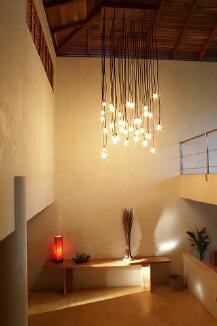lamp and ballast replacement for energy efficiency

Relamping means substituting one lamp for another to save energy. You can decide to make illumination higher or lower when relamping. Be sure that the new lamp's lumen output fits the tasks performed in the space and conforms to the fixture's specifications.
Matching replacement lamps to existing fixtures and ballasts can be tricky, especially with older fixtures. Buying new fixtures made for new lamps produces superior energy savings, reliability, and longevity compared with relamping.
Replacing lamps in incandescent lighting fixtures
You can reduce lighting costs by replacing lamps in or 'relamping' your older indoor and outdoor incandescent lighting fixtures.
Many older indoor lighting fixtures trap a significant portion of light inside the fixture. Newer incandescent fixtures are designed to push all their light out into the room. Others use smaller tungsten halogen lamps. Advances in indoor fixture design include brighter reflectors and better reflecting geometry.
Many incandescent lamps also are mismatched to their tasks or application. Some have excessive wattages and therefore create unnecessarily high illumination. For example, some outdoor fixtures tend to disperse much of their light beyond the intended area, which causes light pollution. This can be corrected by using lamps with smaller wattage.
A-type light bulbs can often be replaced with improved lamp designs, such as reflectors or tungsten halogen lamps. For energy savings of 60–75%, many incandescent lamps can be replaced by compact fluorescent lamps (CFLs). A standard 18-watt CFL replaces a 75-watt A-type lamp. CFLs are especially economical in spaces where lights are needed for longer periods of time.
CFLs are also packaged in the same glass reflector lamps as incandescent
lamps. Use CFLs packaged as ellipsoidal reflectors (type-ER) in recessed
fixtures. Use reflector (R) or parabolic reflector (PAR) CFLs for flood
and spotlighting. Some CFL fixtures have built-in electronic ballasts and
polished metal reflectors.
When used in recessed fixtures, standard A-type lamps and reflector lamps
waste energy because their light gets trapped. To save energy, you could
replace a 150-watt standard reflector with a 75-watt ellipsoidal reflector
(ER). Remember, though, that ER lamps are less efficient at delivering light
from shallow fixtures, so use reflectors or parabolic reflectors for these
purposes.
Replacing lamps and ballasts in fluorescent lighting fixtures
Although fluorescent lamps are generally energy efficient, there are new, even more efficient lamps that use better electrodes and coatings than do older fluorescent lamps. These lamps produce about the same lumen output with substantially lower wattage.
Common 40-watt and 75-watt lamps can be replaced with energy-saving lamps of 34 watts and 60 watts, respectively. Energy-saving lamps for less-common fluorescent fixtures are also available.
If you need to replace the ballasts in your fluorescent fixtures, consider using one of the improved varieties. These fluorescent ballasts, called improved electromagnetic ballasts and electronic ballasts, raise the efficiency of the fixture 12–30%.
Newer electromagnetic ballasts reduce ballast losses, fixture temperature, and system wattage. Because they operate at cooler temperatures, they last longer than standard electromagnetic ballasts.
Electronic ballasts operate at a very high frequency that eliminates flickering and noise. They are even more efficient than improved electromagnetic ballasts. Some electronic ballasts even allow you to operate the fluorescent lamp on a dimmer switch, which usually is not recommended with most fluorescents.
Fluorescent lamp disposal
All fluorescent lights contain small amounts of mercury. Some compact fluorescent lamps with magnetic ballasts contain small amounts of short-lived radioactive material. Because of these hazardous materials, you should not toss burned-out lamps into the trash.
Find out if there is a recycling program for them in your community – they are becoming more common. You can also dispose of the lamps with other household hazardous wastes such as batteries, solvents, and paints at your community's designated drop-off point or during a designated day when you can put such materials with your curb-side trash pickup.
